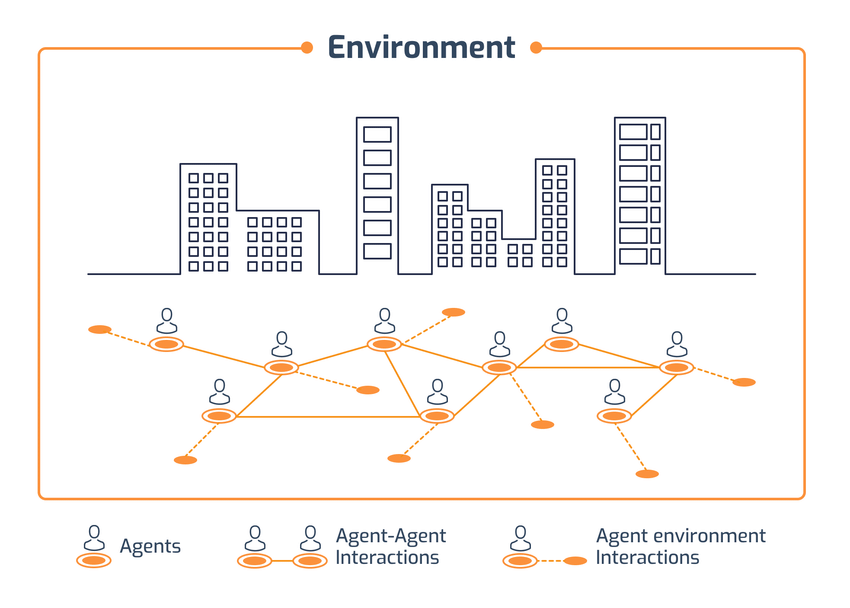
Agent-Based Modeling (ABM) is a computational modeling technique used in the field of artificial intelligence to simulate the actions and interactions of autonomous agents within a given environment. These agents can represent individuals, organizations, or other entities that have the ability to make decisions and interact with their surroundings based on a set of rules or behaviors.
ABM is a powerful tool for studying complex systems and emergent phenomena, as it allows researchers to observe how individual agents’ behaviors can lead to larger-scale patterns and outcomes. By simulating the interactions between agents over time, ABM can provide insights into how certain behaviors or strategies may lead to different outcomes, helping researchers to better understand and predict the behavior of complex systems.
One of the key advantages of ABM is its ability to capture the heterogeneity and autonomy of individual agents within a system. Unlike traditional modeling techniques that rely on aggregate data or assumptions about agent behavior, ABM allows for the representation of diverse and independent agents with their own unique characteristics and decision-making processes. This level of detail and realism can lead to more accurate and nuanced simulations of real-world systems.
ABM has applications in a wide range of fields, including economics, sociology, biology, and ecology. In economics, ABM can be used to study market dynamics and the behavior of individual consumers and firms. In sociology, ABM can help researchers understand how social norms and interactions emerge from the actions of individual agents. In biology, ABM can simulate the behavior of individual organisms within a larger ecosystem.
Overall, Agent-Based Modeling is a valuable tool for studying complex systems and understanding how individual behaviors can lead to larger-scale patterns and outcomes. By simulating the interactions of autonomous agents within a given environment, ABM provides researchers with a powerful tool for exploring the dynamics of complex systems and predicting their behavior in the real world.
1. Improved Simulation Accuracy: Agent-based modeling allows for the creation of more accurate simulations by representing individual agents with unique characteristics and behaviors, leading to more realistic outcomes in AI systems.
2. Complex System Analysis: This approach enables the analysis of complex systems by modeling the interactions and behaviors of individual agents, providing insights into emergent phenomena and system dynamics in AI.
3. Adaptive Decision-Making: Agent-based modeling facilitates adaptive decision-making in AI systems by allowing agents to respond to changing environments and make decisions based on their individual goals and interactions with other agents.
4. Scalability and Flexibility: This modeling technique offers scalability and flexibility in AI applications, as it can easily accommodate a large number of agents with diverse characteristics and behaviors, making it suitable for a wide range of scenarios.
5. Real-World Applications: Agent-based modeling is widely used in various real-world applications, such as traffic management, epidemiology, and financial markets, demonstrating its significance in AI for simulating and analyzing complex systems.
1. Predictive modeling: Agent-based modeling is used in predictive modeling to simulate the behavior of individual agents within a system and predict their interactions and outcomes.
2. Urban planning: Agent-based modeling is used in urban planning to simulate the behavior of individuals, businesses, and government entities within a city to understand how they interact and impact the overall urban environment.
3. Epidemiology: Agent-based modeling is used in epidemiology to simulate the spread of diseases among individuals and populations, allowing researchers to study the effectiveness of different intervention strategies.
4. Traffic simulation: Agent-based modeling is used in traffic simulation to model the behavior of individual vehicles and drivers on road networks, helping to optimize traffic flow and reduce congestion.
5. Supply chain management: Agent-based modeling is used in supply chain management to simulate the behavior of individual agents such as suppliers, manufacturers, and distributors to optimize inventory levels, production schedules, and delivery routes.
There are no results matching your search
There are no results matching your search